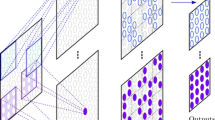Abstract
Radiation dosimetry for the diagnostic medical imaging procedures performed on humans requires anatomically accurate, computational models. These may be constructed from medical images as voxel-based tomographic models. However, they are time consuming to produce and as a consequence, there are few available. This paper discusses the emergence of semi-automatic segmentation techniques and describes an application (iRAD) written inMicrosoft Visual Basic that allows the bitmap of a medical image to be segmented interactively and semi-automatically while displayed inMicrosoft Excel. iRAD will decrease the time required to construct voxel models.
Similar content being viewed by others
References
ICRP,1990 recommendations of the International Commission on radiological Protection, publication 60. Annals of the ICRP, 1991. 21(1–3).
Fisher, H.L. and W.S. Snyder,Annual progress report for period ending July 31 1966,. 1966, Health Physics Division, Report, Oak Ridge National Laboratory.
Snyder, W.S., et al.,Estimates of absorbed fractions for monoenergetic photon sources uniformly distributed in various organs of a heterogeneous phantom, Medical Internal Radiation Dose Committee (MIRD) Pamphlet No. 5. Journal of Nuclear Medicine, 1969. 10(Supplement No. 3).
Cristy, M.,Mathematical Phantoms Representing Children of Various Ages For Use in Estimates of Internal Dose. 1980, Oak Ridge National Laboratory: Oak Ridge Tennessee.
Zankl, M., et al.,The construction of computer tomographic phantoms and their application in radiology and radiation protection. Radiation and Environmental Biophysics, 1988. 27: p. 153–164.
Zubal, G. and C. Harrel,Voxel based Monte Carlo calculations of nuclear medicine images and applied variance reduction techniques. Image and Vision Computing, 1992. 10(6): p. 342–360.
Zankl, M. and A. Wittmann,The adult male voxel model “Golem” segmented from whole-body CT patient data. Radiation and Environmental Biophysics, 2001. 40(2): p. 153–162.
Saito, K., et al.,Construction of a computed tomographic phantom for a Japanese male adult and dose calculation system. Radiation and Environmental Biophysics, 2001. 40: p. 69–76.
Caon, M., G. Bibbo, and J. Pattison,An EGS4-ready tomographic computational model of a fourteen year-old female torso for calculating organ doses from CT examinations. Physics in Medicine and Biology, 1999. 44(9): p. 2213–2225.
Xu, X.G., T.C. Chao, and A. Bozkurt,VIP-MAN: An image based whole-body adult male model constructed from color photographs of the Visible Human Project for multi-particle Monte Carlo calculations. Health Physics, 2000.78(5): p. 476–485.
Jones, D.G.,A realistic anthropomorphic phantom for calculating organ doses arising from external photon irradiation. Radiation Protection Dosimetry, 1997.72(1): p. 21–29.
Dimbylow, P.J.,FDTD calculations of the whole-body averaged SAR in an anatomically realistic voxel model of the human body from 1 MHz to 1 GHz. Physics in Medicine and Biology, 1997. 42: p. 479–490.
Neal, A.J., G. Sivewright, and R. Bentley,Evaluation of a region growing algorithm for segmenting pelvic computed tomography i mages during radiotherapy planning. The British Journal of Radiotherapy, 1994. 67(4): p. 392–395.
Funabiki, J., et al.An EGS4 User Code with Voxel Geometry and a Voxel Phantom Generating System. inSecond International Workshop on EGS. 2000. KEK, Tsukuba, Japan: KEK.
Nelson, W.R., H. Hirayama, and D.W.O. Rogers,The EGS4 Code System. 1985, Stanford Linear Accelerator Centre, Stanford University, California.: Stanford.
Veit, R., et al.,Tomographic Anthropomorphic Models. Part I: Construction Technique and escription of Models of an 8 week Old Baby and a 7 Year Old Child. 1989, GSF-National Research Center for Environment and Health: Neuherberg.
Author information
Authors and Affiliations
Corresponding author
Rights and permissions
About this article
Cite this article
Caon, M., Mohyla, J. Automating the segmentation of medical images for the production of voxel tomographic computational models.. Australas. Phys. Eng. Sci. Med. 24, 185 (2001). https://doi.org/10.1007/BF03178363
Received:
Accepted:
DOI: https://doi.org/10.1007/BF03178363




